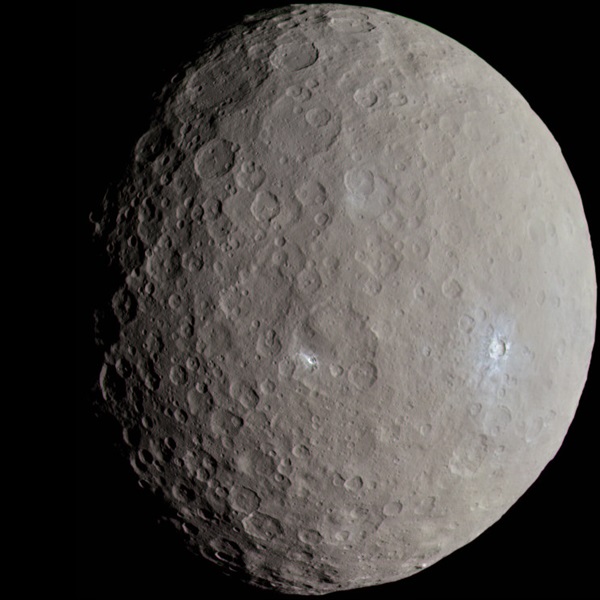Key Takeaways:
Ceres is best known for being the biggest rocky body in the entire asteroid belt, now considered a dwarf planet. The sister to the likes of Pluto, Eris and Makemake, Ceres is turning out to be more complex than scientists initially thought.
When the Dawn spacecraft entered orbit around Ceres in 2015, its mission was to study the planet since it can provide clues about the formation of our solar system and what that environment was like billions of years ago. The team thought they had a chance of finding ice on Ceres, since many asteroids are icy clumps of rock, but they never had evidence of it until now.
In an announcement yesterday at the American Geophysical Union in San Francisco, researchers say they’ve found frozen water ice on the surface of Ceres, stored in its persistently shadowed craters in something called a cold trap.
Ceres, like our moon and Mercury, has a mild axial tilt, so the foot of the craters at their northern regions never see the sun, making sure that whatever water is there, stays put, and it’s likely stayed that way for the last few billion years. The temperature of these craters can get below -260 Fahrenheit, just cold enough that it can take a billion years for the water to turn to vapor.
“These studies support the idea that ice separated from rock early in Ceres’ history,” says Dawn Project Scientist Carol Raymond. “ This separation formed an ice-rich crustal layer, and that ice has remained near the surface over the history of the solar system.”
The team analyzed five months worth of data captured using Dawn’s Gamma Ray and Neutron Detector (GRaND) to come to their icy conclusions. Dawn team member Thomas Prettyman and Principle Investigator of Dawns (GRaND) instrument, based at the Planetary Science Institute in Tucson, Arizona explains how it works, saying, “The high energy particles, from sources like galactic cosmic rays whack against the surface of Ceres and break apart nuclei, producing a spray of secondary particles that include neutrons. The neutrons rattle around in the regolith and some of them escape into space. These neutron emissions are sensitive to light elements, like hydrogen and carbon. The neutrons also undergo reactions that make gamma rays which make a fingerprint for what’s in the surface.”
While the jury’s still out on how exactly Ceres acquired so much water, Prettyman thinks it’s probably been there all along, “ liquid water had to be on the interior of Ceres in order for us to see the minerals we see on the surface, the fact that its surface is that ice rich means at some point in time there was liquid water, whether or not that formed a brine layer is still under discussion.”
Perhaps the most interesting thing about the discovery of water ice on a planet closer to the sun is that Ceres is much warmer than icy moons like Enceladus or Europa, both of which are thought to be potential harbingers of life. Carol Raymond thinks there might be more than meets the eye at Ceres.
“This combination of water and rock, are conclusive for a habitable environment, but we can only look for the chemical fingerprints on the surface, and we have evidence to say that the presence of the subsurface ocean was very likely,” she says. “Ceres is a really interesting object, equivalent to Europa or Enceladus in terms of its habitability potential.”
Of course the notion of habitability is interesting, but there might be a more practical reason to head back to visit Ceres. With talk of future asteroid and lunar mining, the large dwarf planet may end up being a desirable target for water extraction to be used in long-duration space flights. These grand visions are probably still far off in the distance, but until then, Dawn still has some time to explore Ceres and it’s icy activity before the mission ends sometime next year.










